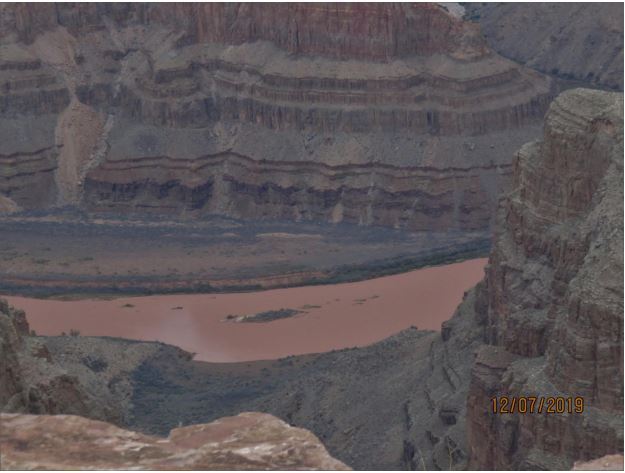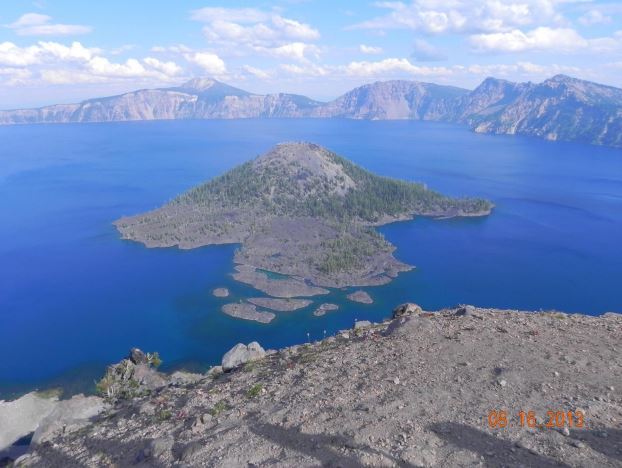by Samhita Vasudevan
Smooth reds, muted oranges, and sandy browns painted the landscape that graced my sight. An overcast sky drizzled almost cautiously onto our heads, while the crunch of the rocky terrain echoed after every footstep, as my parents and I trekked up the precarious path on the West Rim of the Grand Canyon. It was early December of 2019, on the Hualapai Reservation, a site our family reached after a two-hour cellular-signal-less drive from Las Vegas.

As we hiked up the path to the second and last stop of our tour, Guano Point (aptly named considering its history—In the 1930s the U.S. government spent about $3.5 million to extract the nitrogen-rich bat droppings), the terror I felt about being so close to plummeting down hundreds of feet evaporated when an opaque, red-colored Colorado River came into my view. Like a ribbon, it weaved through the towering cliffs, drawing everyone’s attention. Today, however, it was especially eye-catching: its striking color was unlike anything I’d ever seen before.
Prior to the completion of the Glen Canyon Dam in 1963, the reddish color of the Colorado was much more prominent. In fact, the Colorado River’s original name, El Rio Colorado, meaning “the reddish river,” came about when the first Spanish explorers to see the river encountered an even more vibrant red than I did. The river’s color is tied to the amount of sediment its water contains while flowing through the canyon. Since the dam’s construction, however, this color has been dulled severely, as the dam blocks much of the sediment from travelling further downstream. Most days, the river is a clear greenish-blue. The reddish-brown color I saw on my visit can most likely be credited to the rain stirring up the sediments earlier that day.
The subject of sediment reminded me of my other favorite National Park, Crater Lake. Unlike the Colorado River, this waterbody’s bright color is caused by a lack of sediment. In 2013, I found myself boating on possibly the most beautiful body of water I have ever seen: Crater Lake in southwestern Oregon. This roughly 5-mile-wide lake, which formed through the collapse of a volcano more than 7,000 years ago, has no tributaries, or smaller rivers flowing into it. In much of the world today, rivers and their tributaries are impacted by human activities, and the effects travel downstream. The reason Crater Lake has some of the cleanest water in the world is because most of its water comes from melted snow or rain. Being free from the inward flow of potentially contaminated water and sediments, Crater Lake maintains its clarity resulting in one of the deepest, brightest, blues.

As beautiful as both bodies of water are, they can only be protected through active efforts to preserve their sanctity. The Colorado River, a source of water for 40 million people, has been negatively impacted due to climate change, population growth, nearby natural resource exploitation, and the over-allocation of its flow for crop irrigation. Crater Lake has become increasingly at risk due to careless visitors who head onto the lake with items prohibited by the National Park due to their potential to pollute the pristine water. The pandemic has only heightened this chronic problem. Increased visitation has brought an increase in people, knowingly or unknowingly, bringing in prohibited items like wetsuits, kayaks, and innertubes. These materials could introduce non-native species that are known to hitchhike on watercraft, jeopardizing the lake’s ecosystem. Visitors to such natural beauties must accept some responsibility to keep these areas alive and well. These positive outcomes can only be achieved by following park guidelines and being conscious of one’s impact on the environment around them.
Samhita Vasudevan is a Teen Volunteer in the Education Department. Museum employees, volunteers, and interns are encouraged to blog about their unique experiences and knowledge gained from working at the museum.
Sources:
Releasing a flood of controversy on the Colorado River
12 Things You Didn’t Know About Crater Lake National Park
Crater Lakes clear waters under threat
Related Content
Chasing Snails in the Great Smoky Mountains
Carnegie Museum of Natural History Blog Citation Information
Blog author: Vasudevan, SamhitaPublication date: August 16, 2021
